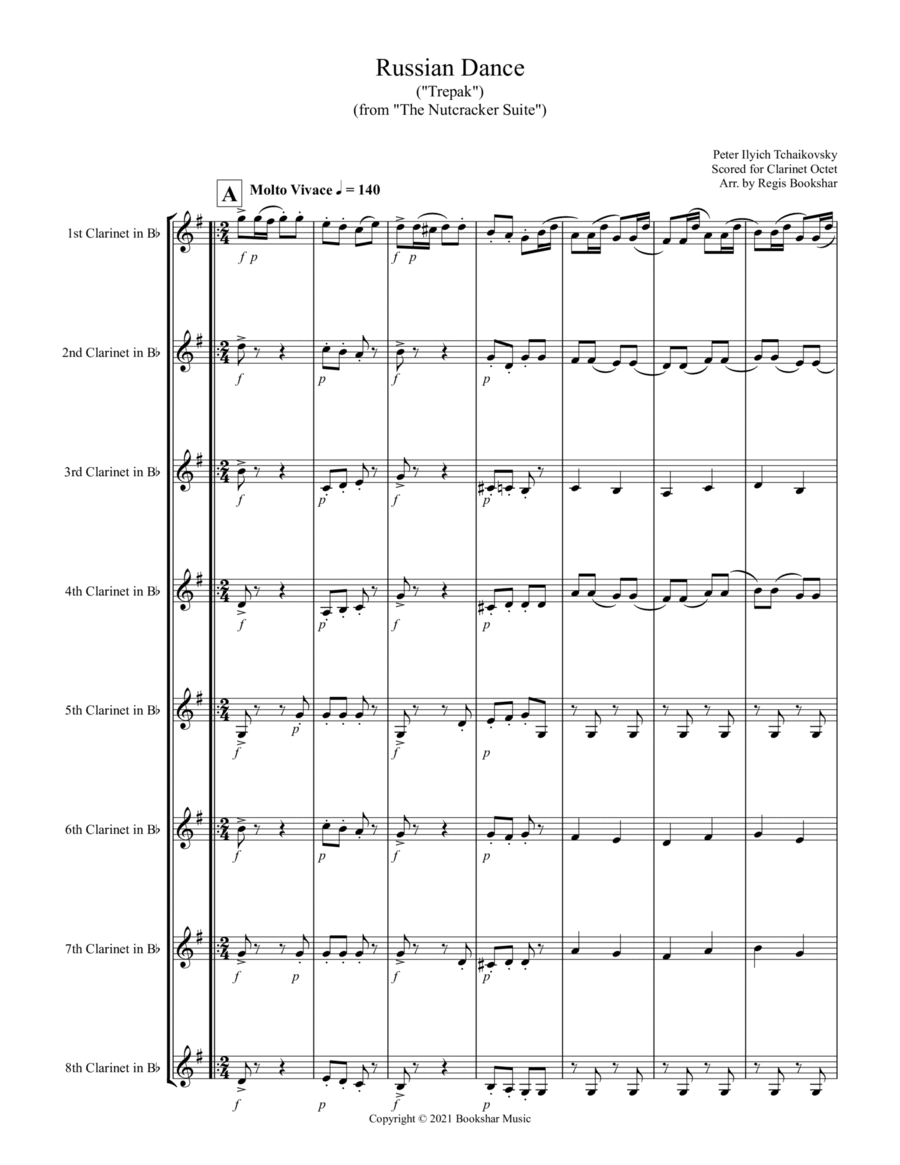Woodwind Ensemble Clarinet - Level 4 - Digital Download SKU: A0.813921 Composed by Peter Ilyich Tchaikovsky. Arranged by Regis Bookshar. Christmas,Romantic Period,Standards. 15 pages. Regis Bookshar #6615137. Published by Regis Bookshar (A0.813921). Clarinet Octet - Advanced/Intermediate - Digital Download. This marvelous arrangement of the Russian Dance from Peter Ilyich Tchaikovsky's extremely popular, The Nutcracker Suite, would be a fabulous addition to any music library and could be performed for concerts and recitals but would be most appropriate during the Holiday season. This selection has been arranged to keep all of the intensity and excitement of the original composition and is suitable for high school and college students but professional musicians would also enjoy playing this selection. Included are a score and a complete set of parts (15 pages). This selection is one of the many arrangements from The Regis Bookshar Trumpet Ensemble's extensive music library which are being made available for the first time.The Nutcracker is an 1892 two-act ballet with a score by Peter Ilyich Tchaikovsky. It has enjoyed enormous popularity since the late 1960's and is performed by countless ballet companies, primarily during the Christmas season, especially in North America. Tchaikovsky's score has become one of his most famous compositions. Some critics have called it astonishingly rich in detailed inspiration and from beginning to end, beautiful, melodious, original and characteristic. The ballet's first complete performance outside Russia took place in England in 1934. The first complete United States performance was on December 24, 1944, by the San Francisco Ballet. It was such an enormous success that the San Francisco Ballet has presented The Nutcracker every Christmas Eve and throughout the winter season, debuting new productions in 1944, 1954, 1967 and 2004. In Salt Lake City, it has been performed every year since 1963. The New York City Ballet gave its first annual performance in 1954. In addition to annual live stagings of the work, many productions have also been televised or released on home video.The Nutcracker continues to be one of Tchaikovsky's most popular compositions and contains some of his most memorable works. Tchaikovsky made a selection of eight of the numbers from the ballet before the ballet's December 1892 premiere, forming The Nutcracker Suite, Op. 71a, and is intended for concert performance. The suite was first performed, under the composer's direction, on March 19, 1892. The suite became instantly popular with almost every number encored at its premiere.Regis Bookshar thought that it would be wonderful if other instrumentalists could also have the opportunity to play some of these wonderful compositions, originally scored for a full orchestra, and has arranged two of the selections, the popular March and the Russian Dance, one of the character dances, based on the Russian and Ukrainian folk dance, Trepak, for a wide variety of instrumental ensembles. So, in addition to this version of the Russian Dance, for a Clarinet Octet, he has made quite a few other arrangements of this selection for various Quintets and Octets and are readily available. If you should decide to purchase this arrangement of the Russian Dance, I would highly encourage you to also consider purchasing the arrangement of the March as well. Scheduling the March followed by the Russian Dance would be a very satisfying addition to any concert or recital. Please take the time to look for other versions of these compositions. You may find something else that might also suit your needs.I would also encourage you to search for other arrangements by Regis Bookshar, as there are numerous selections in a variety of styles, also available for purchase. You may find something else which might interest you. Please continue to check periodically because new arrangements are being added as often as possible. I'm certain that this wonderful arrangement of the Russian Dance from Tchaikovsky's marvelous holiday favorite, The Nutcracker Suite, will continue to entertain both performers and audiences.
